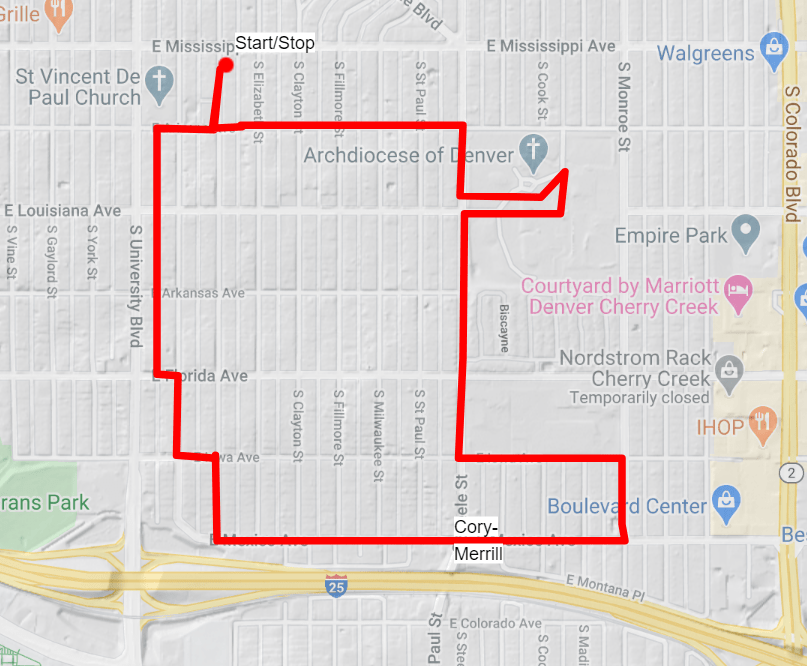Two Schools, Two Seminaries, and One Log Cabin

In a neighborhood named after two Denver Public School teachers, containing several other religious schools and housing two seminaries, it’s no surprise that at one time this neighborhood was dry–as in no alcohol allowed. Large landowners dominate the flavor of the neighborhood that’s decorated with a log cabin, Frank Lloyd Wright-style architectue, and religious icons throughout the neighborhood. Take a walk through Cory-Merrill on this urban hiking adventure.
The neighborhood takes its name from the schools. John J Cory, a native of Denver, grew up in Denver schools, eventually becoming the principal of West High School. He went on to become the assistant superintendent at Emily Griffith. Louise A Merrill was a pioneer in junior high school education, becoming principal of Byers School. Her nickname was Ludie, and she is buried at Fairmount Cemetery.
A “Town” of Boom But Not a Lot of Bust

Cory-Merrill sits in a rectangle shape with the boundaries of I-25, Mississippi, Colorado, and University. Originally part of the “Town of South Denver,” it was dry and sought the moral ground. No one wanted the noise and hoopla of saloons, like those in nearby Denver, in their town.
But economics soon won out, and Cory-Merrill’s citizens voted to annex to Denver. The local hero at the time, Mr Armstrong, donated land for Cory Elementary and Merrill Middle (named after two influential Denver educators) to be built, and Les Tramblay built rows and rows of soldier housing for the post-World War II boom.
Open Spaces, But No Parks

The largest landowner in Cory-Merrill is definitely the Catholic church. Sitting right in the middle of the ‘hood is the Archdiocese of Denver with its two seminaries, a church, and even the 12 Stations of the Cross. The entire campus takes up acres and acres of the neighborhood, providing the only open space beyond the school playgrounds. Although the space is open, it is still private and held by the church.

The second largest collective landowner must be the schools, with not only the large Cory Elementary and Merrill Middle run by Denver Public Schools taking up residence but also several smaller religious schools dotted throughout the neighborhood. Interestingly, there is no Denver Park property anywhere in the neighborhood.
A Variety of Architectural Decades

Cory Elementary’s architectural style has remained and highlights the neighborhood and is listed as a historic landmark. The Usonian style, modeled after Frank Lloyd Wright, was executed by local visionary Victor Hornbein, a Denver native. He is most famous for the Conservatory at the Denver Botanic Gardens and his favorite design, the Ross-Broadway Library. Hornbein graduated from Denver’s very own East High School and won an award for his excellent work in architecture, including a book on Frank Lloyd Wright’s architecture that changed his life.
Like other Denver neighborhoods near downtown, Cory-Merrill’s cheapest homes have fallen victim to scraping and rebuilding. But it’s a little different here. It seems that in the late 90s/early 2000s, many homes disappeared, making way for larger re-dos. Then it seems time stood still for a while, and now the developers are back, finding creative ways to increase density and restore/remodel/redo some of the neighborhood’s unique character.

Overall, the architectural history is varied. Many 1940s homes still stand. There are a few homes from what appears to be the 60s/70s, then there’s a jump to 90/2000’s, and then a gap again until now. The again, there is a log cabin smack in the middle of the residences! Does anyone know why?

Walking Cory-Merrill’s rectangle requires a good jig and then a jag. Make sure to spend time on the Archdiocese grounds, if they are open and allowing visitors. The Stations of the Cross are interesting in themselves. They depict the twelve stages Jesus went through as his body made its way to its cruxification.
The Route (click for interactive map):
Park near 1117 S Columbine. Walk south to E Arizona, go right, passing St Vincent de Paul School on the right.
At South Josephine, take a left. At E Florida Ave, take a left. Enjoy the log cabin!
Take a right on Columbine, then take a left on Iowa.
Take a right on Elizabeth. Take a left on E Mexico Ave.
Continue along Mexico to Monroe. Take a left on Monroe. Notice the house at 1695 S Monroe. Once a Les Tremblay soldier home like many of the neighbors’ homes across the street, it was originally 623 square feet and sold for $8200. Times have changed!
Continue north on S Monroe to E Iowa Street. Go left (west) to Steele St. On Steele, to the right (north).
In a few blocks, you’ll come to the entrance to the Archdiocese on the right. Enter the grounds and meander over to the left of the church to see the 12 Stages of the Cross and the large tower of the church. You’ll want to be sure that the grounds are open to the public and that a private event might not have closed access to the grounds.
When you’re finished at the Archdiocese, continue north on Steele. At Arizona, take a left. At Columbine, take a right, returning you to the start of this 3-mile Cory-Merrill urban hike.

